
José Martí
"Socialist ideology, like so many others, has two main dangers. One stems from confused and incomplete readings of foreign texts, and the other from the arrogance and hidden rage of those who, in order to climb up in the world, pretend to be frantic defenders of the helpless so as to have shoulders on which to stand."
José Martí, you were a visionary who saw what 'socialism' would bring to any nation that toyed with that evil idea. You knew that system well, and the ones that promoted it also. Hard to believe you knew its true nature well over 120 years ago. -
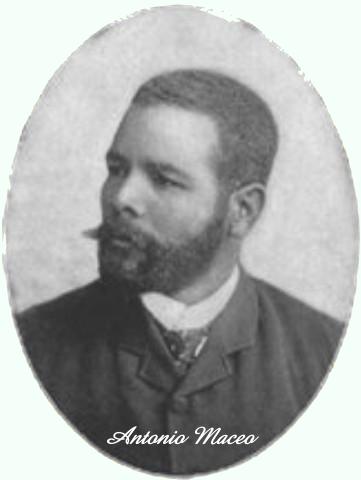
"My duties to Country and to my own political convictions are above all human effort;
for these I shall reach the pedestal of freedom or I shall perish fighting for the redemption of that land. . ."
General Antonio Maceo Grajales
* * * * * * * * * * * * * * * * * * * * *
Antonio de la Caridad Maceo is one of five children born to Marcos Maceo and Mariana Grajales. Marcos emigrated to Cuba from Venezuela. Mariana was a free Cuban slave born in Santiago de Cuba, in the Oriente Province June 26 1808; her ancestors had been brought to Cuba from West Afica. Her common law union to Marcos was her second one. Mariana Grajales was widowed when she met Marcos Maceo and had four children from her previous spouse, bringing the total of Mariana's offspring to nine children.
Industrious Marcos had a small agricultural business. The business prospered economically and the family was able to purchase several farms in Santiago. Unlike the majority of Black Cubans, the Maceo family was part of the rural middle class of the Oriente province. Antonio was educated at home by three teachers.
At the age of 16, he began working, transporting and marketing fruits and tobacco by mule. When he was 19 years old, he became a member of the Masonic Lodge of Santiago and entered the inner revolutionary circle against Spain. At the age of 21, Antonio married María Magdalena Cabrales Fernández, with whom he had a daughter, María de la Caridad Maceo.
Militarily trained by Máximo Gómez, Antonio's military strategy and prowess won him the nickname of "The Bronze Titán". General Antonio Maceo lived to see the end of slavery in Cuba in 1886, but unfortunately he did not survive to see the end of Cuba's domination by Spain, which finally occurred in 1898, scarcely two years after his death while battlig Spanish forces.
The priceless contribution of the Maceo family to the cause of Cuba's freedom is exemplary. Mariana Grajales contribution to Cuba's Freedom wasn't limited to sending her sons to battle the Spanish oppressor, she also took to the hills herself when the need to do so arose.
Mariana was the role model of the brave Cuban women who followed in her footsteps, to the battlefield for the liberation of Cuba and the abolition of slavery. Mariana Grajales holds a special place in the heart of all freedom loving Cubans everywhere.
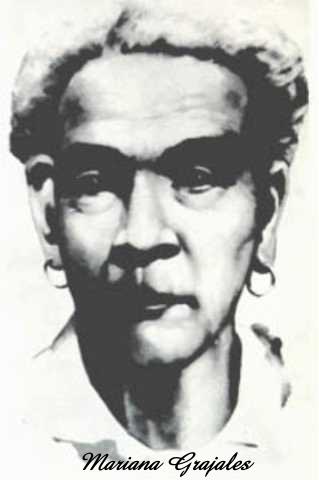
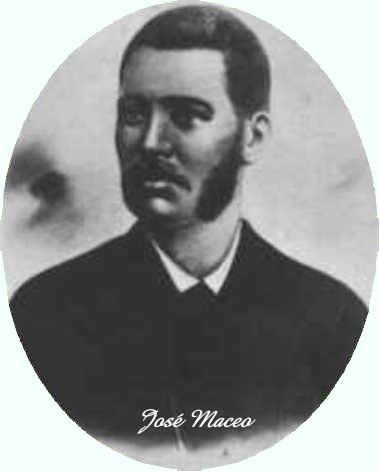
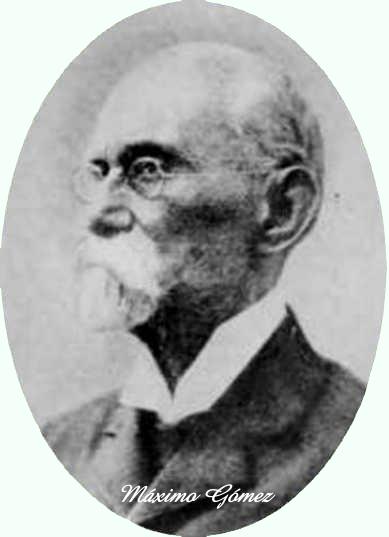
By Jorge Benitez Sagol
Author of "DEAR UNCLE SAM"
The history of the Cuban people changed dramatically on Saturday, April 22, 2000. On that fateful day in Miami, the government of the United States of America, the wealthiest and most powerful country on Earth, accomplished what 41 years of Cuban dictatorship could not, it taught us, the Cuban American exile community, to stand up for ourselves. Whatever illusions we held about our relationship to this country were shattered in a few minutes; and at that moment, an entire generation, raised or even born in exile, realized the futility of assimilation and became fully Cuban, and Latin American. The kidnapping of Elián González by agents of the Immigration and Naturalization Service (INS) goes beyond a simple and superficial act of collaboration between an unprincipled American president and a fascist regime. In fact, no conspiracy theory can explain the profound hatred which numerous American politicians, intellectuals and journalists have expressed toward Cuban Americans over the past weeks. It would require a book to fully analyze such anti-Cuban sentiments.-
October 27, 1492 - Christopher Columbus discovers Cuba and claims the island for Spain. Cuba is quickly colonized and the Cuban native population is decimated to almost the point of extinction. In the period that follows, the Spaniards turn to Western Africa in search of slaves to replace the dwindling native population. Most of the "imported" Western African human beings are descendents from the ancient Yoruba Empire, from the general area of what today is known as Nigeria, Benin (formerly known as Dahomey) and Togo. Close to 50% of them perish in the bowels of the slave trader ships while in transit to the island. The ones who survive the trip are "allowed" to keep their identities and religious practices for a brief period.
After being "Christianized" by their masters, their religious rites continue to be observed in secret. They cleverly use Catholic symbols and statues to represent their Deities. The Yoruban OCHUN was worshipped through Our Lady Of Charity, YEMAYA through Our Lady Of Regla, CHANGO through St. Barbara, OYA through St. Therese of Lissieux, BABALU AYE through St. Lazarus, OBBATALA through Our Lady Of Mercy and so on. Through this clever process Spaniards are fooled into believing their slaves had truly "converted" to Catholicism, and were even permitted to use basic hand made african instruments to play their ritual music in honor of the Catholic "saints" they were "worshipping". These are the roots of what later on would become known as "Santeria" (the adoration and worship of saints is a good term to translate this Spanish word to English) in Cuba. Santeria is a religion that permeated all aspects of Cuban life back then and continues to do so to this day in the island; as well as wherever you may find Cuban expatriates including well over two hundred thousand here in the USA alone. Even Castro is a practitioner of Santeria Rites.
Spaniards attracted by the mild Cuban climate and beautiful landscape were also moving to the Caribbean island in large amounts. Some of their offspring were considered a mixed race since the salve masters were using female African slaves to satisfy their sexual urges. Some of these are referred to as "mulatos or morenos", though they were still considered to be slaves.
By the way, mulato is the correct Cuban spelling for this word. Morenos are a bit lighter in complexion than mulatos. In some cases morenos have green or blue eyes, the hair texture is rather fine, their bodies well proportioned and their facial features are very beautiful.
In time some of the Spanish white offspring born in Cuba begins to resent the treatment of Cuba and its citizens by Spain’s monarchy; a slow growing Anti-Spanish movement is born. This will be a period of extreme harsh treatment for the Cuban population at large at the hands of the brutal Spanish oppressors. The fact that most of these revolutionaries are direct descendents of the Spanish conquerors (both maternal as well as paternal) will not deter the monarchy in Spain from ruling the island and its population with an iron fist. The year 1868 marks the beginning of Cuba's struggle for freedom, a struggle that continues to this day.
October 10, 1868 - Cuba's First War of Independence, known as The Ten Year War, begins when plantation owner Carlos Manuel de Cespedes frees and arms his slaves and, accompanied by 37 other planters, proclaims the Independence of Cuba. Two days later the brothers Antonio and Jose Maceo join the group and some Dominican exiles including Maximo Gomez who helps train the insurgents.
April 10, 1869 - As the rebels continue their fight against Spain, they call a Constituent Assembly in Guaimaro where they prepare the first Constitution of the Republic of Cuba and elect Carlos Manuel de Cespedes as their first President.
September 26, 1872 - Colombian Foreign Minister Don Gil Columje proposes a plan to achieve Cuban Independence and the Abolition Of Slavery. The plan, which would be carried out under the leadership of the United States, calls for the reimbursement to Spain for the loss of its colony with money raised from the other Latin American Republics. The Latin American governments agree but U.S. President Ulysses S. Grant vehemently rejects the proposal as North American big business interests have other plans for Cuba. True freedom for the Cuban population is not part of their plans, though.
March 22, 1873 - Carlos Manuel de Cespedes, president of the Republic in rebellion against Spain, asks the United States to support Colombia's plan. The U.S. government withholds its support again. The U.S. government does not offer its cooperation when the plan is revitalized the following year.
November 1875 - As domestic pressure grows, U.S. Secretary of State Hamilton Fish proposes that the European countries pressure Spain to end the fighting in Cuba.
February 8, 1878 - A peace agreement is proposed by Spanish General Arsenio Martinez Campos and it is accepted by the majority of the House of Representatives, the official body of the Spanish ruled Republic of Cuba in Arms.
February 10, 1878 - The Zanjon Pact formalizes the agreement and is signed against the opposition of rebel leaders including General Antonio Maceo, because it neither provides Independence for Cuba nor abolishes slavery.
March 15, 1878 - General Maceo and General Martinez Campos meet at Mangos de Baragua where Maceo explains the rebel's opposition to the Treaty. This meeting becomes known as the Protest of Baragua.
March 23, 1878 - After an eight-day truce between General Maceo and General Martinez, the fight resumes.
May 1878 - The remaining rebel forces surrender marking the official end to The Ten Year War.
October 7, 1886 - Slavery is abolished in Cuba by Royal Decree because economic conditions make it more profitable to free the slaves and hire them to work by day, thus avoiding the expense of year round support.
1892 - José Martí, a Cuban writer in exile for his support of Cuban Independence, spends two years organizing Cubans both inside and outside the island to work for Cuba's Independence through his newly formed Cuban Revolutionary Party. This is the same Party that will be outlawed by Fidel Castro when he takes over the reins of Government in Cuba January 1st of 1959.
1895 - By the beginning of the year U.S. Investments in Cuba have mushroomed to well over $50 million USD. Take note of this fact as it alone will play a pivotal role in the decision making process in Washington for many decades to come.
February 24, 1895 - The Cuban Revolutionary Party declares the beginning of The Second War for Cuban Independence.
March 31, 1895 - Antonio and José Maceo land in eastern Cuba from Santo Domingo.
April 11, 1895 - José Martí and Maximo Gomez land in eastern Cuba from Costa Rica.
May 19, 1895 - José Martí is killed in battle at Dos Rios in eastern Cuba.
July 5, 1896 - José Maceo is killed at the battle of Loma del Gato.
December 7, 1896 - Antonio Maceo (The Bronze Titan) is killed at the battle of Punta Brava in Western Cuba (Havana Province).
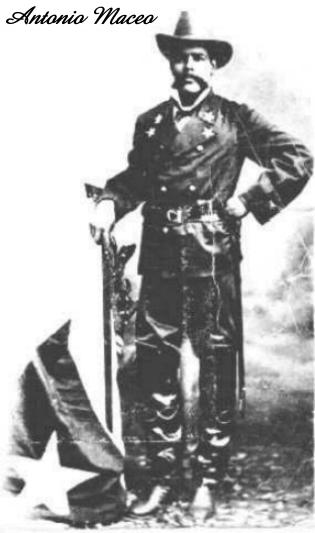
November 1897 - Spain's Queen Regent offers autonomy to Cuba, but both the insurgents and the Cuban loyalists reject the offer. U.S. Assistant Secretary of the Navy Theodore Roosevelt urges President William McKinley to intervene.
December 1897 - As the insurgents are close to achieving success, President McKinley still refuses to recognize Independence for Cuba and its people.
January 1898 - After several staged violent pro-Spanish demonstrations have occurred in Havana, the United States citing increased "danger" to U.S. citizens living in Cuba, sends the battleship Maine on a "friendly" visit to Cuba.
February 15, 1898 - The battleship Maine blows up in Havana Harbor under very mysterious circumstances, killing 260 officers and crew. The United States media led by "yellow journalist" William Randolph Hearst "blames" Spain and manufactures the cry "Remember the Maine."
April 10, 1898 - Spain, not wanting a conflict with the United States, orders a unilateral suspension of hostilities and sends a message to Washington stating that Cuba will be granted autonomy. The U.S. can indicate the terms of an armistice and the matter of the Maine will be submitted to arbitration. This message is ignored by the McKinley administration. As we shall see further down this Chronology, the reasons for Cuba's woes to this day rest at President William McKinley administration's doorstep.
April 11, 1898 - President McKinley sends a message to Congress asking for authority to intervene militarily in Cuba. The message states that, "The only hope of relief and repose from a condition that can no longer be endured is the enforced 'pacification' of Cuba." The term 'pacification' will be used by many subsequent US administrations when their desire to intervene in other nation's internal affairs needs justification.
April 20, 1898 - Congress passes the "Teller Amendment" affirming that the United States has no "intentions to exercise sovereignty, jurisdiction, or control over said Island except for the pacification thereof." Five days later the U.S. declares war on Spain and the Spanish American War begins.
August 12, 1898 - Spain and the United States sign an armistice agreement marking the end of the four-month war.
December 10, 1898 - The United States and Spain sign the "Treaty of Paris" ending Spain's four centuries of domination over Cuba. Although not a single representative from the Cuban Insurgent side is present at the treaty signing, the treaty officially grants Cuba its "independence" and declares the country to be a "free" and "independent" nation.
January 1, 1899 - The United States installs a military government in "free" Cuba under General John R. Brooke who becomes its first U.S. "military governor".
December 23, 1899 - General Leonard Wood, a seasoned veteran of the vile U.S. repressive campaigns against the Native American population, replaces General Brooke as Cuba's "military governor".
November 1900 - A Cuban Constitutional Convention is called and a Constitution is drawn up, and modeled after the U.S. Constitution.
March 2, 1901 - The U.S. Congress passes the Platt Amendment limiting the rights of "free" Cuba to conduct its own foreign policy and granting the United States the right to intervene in Cuba for "the maintenance of a government adequate for the protection of life, property, and individual liberties." The Amendment also grants the United States the right to establish coaling and naval bases on Cuban territory which leads to a treaty signed on July 2, 1903 between the United States and Cuba permitting the establishment of a U.S. Naval Base at Guantanamo Bay.
March 1901 - The Platt Amendment is presented to the delegates of Cuba's Constitutional Convention who are angered by the terms of the Amendment stating that Cuba's long sought Independence would be threatened by U.S. demands that would withhold Cuba's sovereignty. Unfortunately, the protests and objections ultimately succumbed to Cuba's desire to end the U.S. military presence on the island and the delegates "conceded" to include the Platt Amendment as an appendix to Cuba's 1901 Constitution.
1901 Elections - General Leonard Wood "oversees" the “democratic elections” for national offices in Cuba; however some classes of Cubans are excluded from voting. All black Cubans, mulatos, females and those having a net worth of less than $250 (USD) are prohibited from voting. Unless you are a white Cuban having $250 in U.S. currency to your name, you won't be allowed to vote. $250 USD in 1901 Cuba would be like akin to demanding from every US voter in the year 2000 to have ONE MILLION U.S. DOLLARS in assets before they are allowed to vote. As a direct consequence of this specific requirement, the vast majority of white Cubans are excluded from this "election", not to mention all females, blacks, mulatos and the handful of surviving Cuban Taino Indians. Only a handful of wealthy white Cubans vote Don Tomas Estrada Palma as Cuba's first "elected President". The bloody comedy of errors that will culminate with the Castro takeover of Cuba in 1959 now commences.
May 20, 1902 - President-elect Tomas Estrada Palma is sworn in as Cuba's first president and the three year U.S. military presence apparently "ends".
May 23, 1902 - The Platt Amendment is incorporated into the "Permanent Treaty" signed by the United States and Cuba. (The Platt Amendment will be abrogated in 1934 when Colonel Fulgencio Batista emerges as the strongman in control of Cuba's government)
From its earliest days of Independence, Cuba has been plagued with corrupt government leaders. Using the strength of military power and the backing of U.S. special interests, these men manipulate the political process to install themselves as presidents or to become the strongmen behind a given president.
1906 to 1917 - Cuba elects three presidents; during this same period, on three separate occasions the United States, under the "provisions" of the Platt amendment, sends troops and ships to Cuba to "quell" internal uprisings led by groups attempting to overthrow the government who accuse their leaders of corruption and ruthless repressive practices against the Cuban citizenry.
1921 to 1932 - Cuba elects two new presidents. During these thirteen years insurrections continue. These are led by various Cuban groups opposed to the ongoing corrupted practices of government officials in close collaboration with the U.S. administrations and North American businesses with massive financial investments in Cuba.
August 12, 1933 - With the country on the verge of revolution, Cuban president Gerardo Machado, facing the threat of a general strike and the defection of his military resigns from office. With the approval of the United States a new President, Carlos Manuel de Cespedes, is "appointed" to that office.
September 4 & 5, 1933 - The "Sergeant's Revolt," led by Sergeant Fulgencio Batista Zaldivar overthrows the new Cuban president and a five man junta takes over power. The United States fearing the group has "communistic" ideas threatens military intervention and a new president is appointed on September 10. The U. S. does not officially recognize that new government either.
January 15, 1934 - Batista, now a colonel, overthrows the president and within three days systematically appoints and replaces three presidents with the last one receiving U.S. approval.
May 29, 1934 - With Colonel Batista firmly in charge of the government, Cuba and the United States sign a "Treaty on Relations", which abrogates the "Permanent Treaty" of 1903 and the Platt Amendment. The new treaty continues to permit the United States to lease the site of their Naval Base at Guantanamo.
In 1936 Colonel Batista becomes General Batista and continues to function as the strongman behind the appointment or "election" of the next three Cuban presidents.
In 1940 General Batista is "elected" as Cuba's fourteenth president.
In 1943 President Batista legalizes the communist party which was formed in Cuba in 1925.
In 1944 President Batista's choice for succeeding him, as president is defeated and Batista goes into self-imposed exile. During the next four years U.S. organized crime bosses gain a foothold in Cuba through gambling, drug trafficking and prostitution. These businesses will operate with impunity until the Castro regime confiscates all their properties in 1959.
In 1948 A new president is elected and Batista is elected to the Cuban Senate in a campaign that he runs from Florida.
March 1952 - Fidel Castro, a law school graduate in 1950, runs for Congress as a candidate of the Orthodox Party.
March 10, 1952 - Batista again runs for president, however realizing that he will not win the elections he stages a successful coup. Upon ascending to power the elections are cancelled, the Constitution is suspended as Batista becomes a dictator. Within days the Truman Administration officially recognizes his government and begins sending military and economic aid. Batista rules Cuba using brute force to suppress the opposition and is repeatedly accused of torturing and killing suspected rebels and their sympathizers. As Batista increases the use of force to maintain order and control, organized insurrections become more frequent and revolutionary groups pop up all over the country. In response Batista initiates merciless bombing campaigns on suspected rebel strongholds indiscriminately killing men, women, and children in Cuba's countryside.
July 26, 1953 - Fidel Castro, his brother Raul, and a group of armed men attack the Moncada Army Barracks in Santiago de Cuba. Seventy are killed and Fidel and Raul Castro are captured and imprisoned. The Catholic Church Hierarchy (Msgr. Pérez Serante) is advised of a plot by Batista’s government to poison Castro while he is in prison. The Catholic Church's powerful influence in Cuba intervenes, thus thwarting the government's plans to eliminate the Castro brothers.
October 16, 1953 - Fidel Castro, his brother Raul, and the other survivors are brought to a secret trial where Castro states his defense as "History Will Absolve Me" (Castro's version of "Mein Kampf". During the trial he describes the type of society he would like to create, keep and capitalize. Known as the Moncada Program, achieving this model society becomes the basic program and goal of the July 26 Movement and the Cuban Revolution.
May 15, 1955 - As public sentiment builds for the revolutionary movement, General Batista releases Fidel Castro and his men who are then exiled to Mexico where they begin to organize a return to Cuba to re-launch their revolution.
December 2, 1956 - Fidel Castro, his brother Raul, Ernesto "Che" Guevara and seventy-nine other men arrive in the Oriente Province in eastern Cuba, aboard the cabin cruiser Granma. All but twelve of the guerrillas are killed in early fighting. Castro and the survivors join with others fighting Batista and establish a base in the Sierra Maestra Mountains.
Castro is being influenced by Guevara’s marxist-lenininst beliefs and goals for Cuba and Latin America. Castro is fully aware that the only way to absolute power in Cuba will be by insurrection and the installation of a communist dictatorship. These thoughts are to be a well kept secret between Guevara, Fidel and Raul Castro if they are to succeed in their quest for total domination of Cuba and its resources.
March 13, 1957 - Cuban students attack the Presidential Palace in an attempt to assassinate General Batista. The plot fails miserably and it provokes a blood bath of unparalleled proportions in Havana's history.
July 15, 1957 - Earl T. Smith arrives in Cuba as the new U.S. Ambassador.
July 30, 1957 - U.S. Ambassador Smith, who has been very supportive of the Batista regime, now calls the violence excessive after he observes Batista's police beat up women at the funeral of slain suspected revolutionaries.
March 14, 1958 - General Batista continues his reign of torture and killing of suspected rebels and their sympathizers, in addition to bombing raids of entire villages in the Sierra Maestra mountains. The Eisenhower Administration under increasing pressure to withdraw their support from Batista, declares a Cuban arms embargo against the protest of Ambassador Smith.
November 1958 - In an effort to maintain government stability, Ambassador Smith suggests that a free election be held in Cuba in the hope that it would produce an alternative to both Castro and Batista. However Batista's candidate wins an election which Ambassador Smith "believes" to have been rigged by the dictatorship.
December 9, 1958 - William D. Pawley, an emissary from the Eisenhower Administration, meets secretly with General Batista to try and persuade him to leave office and accept exile in Florida. The emissary proposes that the government be left in charge of a U.S. "approved" junta. Batista refuses the offer.
Three weeks later he is forced to flee Cuba as the Eisenhower administration threatens to use the U.S. Marines to “pacify” Cuba once again. By this time, the insurgent forces have advanced as far as Santa Clara (middle Cuba) and a take over of the government before the Eisenhower administration has an excuse to send the U.S. Marines in appears imminent.
Replies